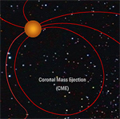In the Classroom
We are dedicated to advancing scientific knowledge in the classroom. The following programs are designed to help and assist teachers in classroom-setting learning. These programs are designed for various age groups and different subjects.
Exploring Magnetism

A Teacher's Magnetism Guide for grades 6-9. This guide features two sessions with a total of seven activities to teach students about magnetic fields and electromagnetism.
- A summary of this lesson for teachers is available here.
- You can view .pdf files for this lesson here.
- Download a simplified activity for grades 4-8 here (.pdf format, 374 KB).
Exploring Magnetism in the Solar Wind

A Teacher's Magnetism Guide for grades 6-9. This guide features a session with three activities to teach students about the , its solar wind, and the interplanetary magnetic field. Students act as STEREO IMPACT space science engineers designing an instrument to measure the interplanetary magnetic field.
- A summary of this lesson for teachers is available here.
- You can view .pdf files for this lesson here.
Exploring Magnetism in Solar Flares

A teacher's activity guide for grades 8-12. This guide features a session with 4 activities that explore magnetism on the 's surface leading to sunspots and Solar Flares. Students learn about these concepts using real data from the RHESSI spacecraft, use math, language, and communication skills.
- A summary of this lesson for teachers is available here.
- You can view .pdf files for this lesson here.
ACE RTSW Data and Traditional Physics Problems Grade 9 - 12
This investigation provides an opportunity for the learner to access some real-time Advanced Composition Explorer (ACE) spacecraft data. The learner will use a variety of information about the ACE spacecraft to solve sample physics problems dealing with conversion factors, kinematics, mass/weight, momentum, and work/power/energy. In the investigation the learner is provided with the appropriate physics equations and conversion factors and is asked to solve the problems.
Interpreting Realtime ACE Data From Space Grade 9 - 12
This investigation provides an opportunity to use realtime data being collected by scientists who are working on the cutting edge of space science. In a science classroom, the investigation can be tied in with a unit on basic atomic structure, states of matter, or space science. In a mathematics (algebra) classroom, the investigation may be used to show a practical application of logarithmic plots. In part one of this investigation the learner will become familiar with the Advanced Composition Explorer (ACE) spacecraft and the scientific goals of the ACE mission. In part two of the investigation the learner will interpret ACE Browse Data Plots and speculate on the type of solar activity being measured.
Space Weather and You! Introduction 1 Grade 5 - 8
This investigation provides an introduction to a topic that is on the cutting edge of space science. The investigation can be tied in with Earth Science content on the and solar system structure, meteorology and weather prediction (in space, as it parallels that on Earth) and spacecraft and what they do. It also applies reading across the curriculum by using a graphic organizer.
Space Weather and You! Introduction 2 Grade 9 - 12
This investigation provides an opportunity to see and use realtime data collected by scientists who are working on the cutting edge of space science. This investigation can be adaptable to a variety of learners. In this investigation the learner will explore the relationship between solar storms and solar cycles, like the sunspot cycle. The learner will explore web sites related to space weather and its resources. The learner will also access plots of live data and recorded data, and be challenged to relate the two.
Space Weather and You Grade 9 - 12
This investigation provides an opportunity to see and use real time data being collected by scientists who are working on the cutting edge of space science. The investigation can be tied in with Physics (kinematics, magnetism) and Earth Science content on the and solar system structure, meteorology and weather prediction (in space) as it parallels that on Earth, and spacecraft and what they do. It also blends the use of teaching across the curriculum by integrating data analysis and mathematics.
Coronal Mass Ejection Animation

See what happens to Earth and the STEREO satellites during a Coronal Mass Ejection.
(Requires Adobe Flash--get it free here).
Sounds of Space

Learn about converting observations of the and Sun-Earth environment into sounds and hear these conversions.
NASA's Space Math Page
This web page contains problem sets for the Weekly Space Science Problem program. The goal of these problems is to teach students about space weather by using mathematics.



